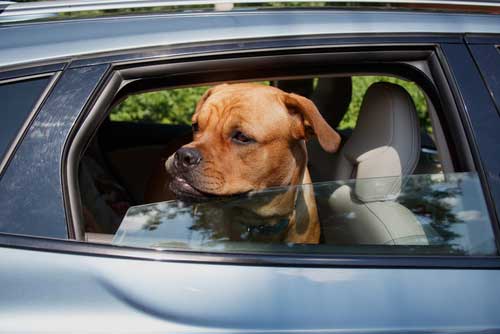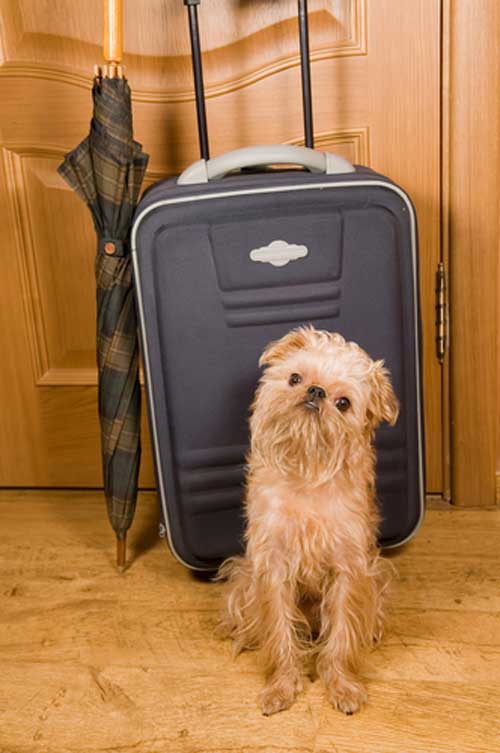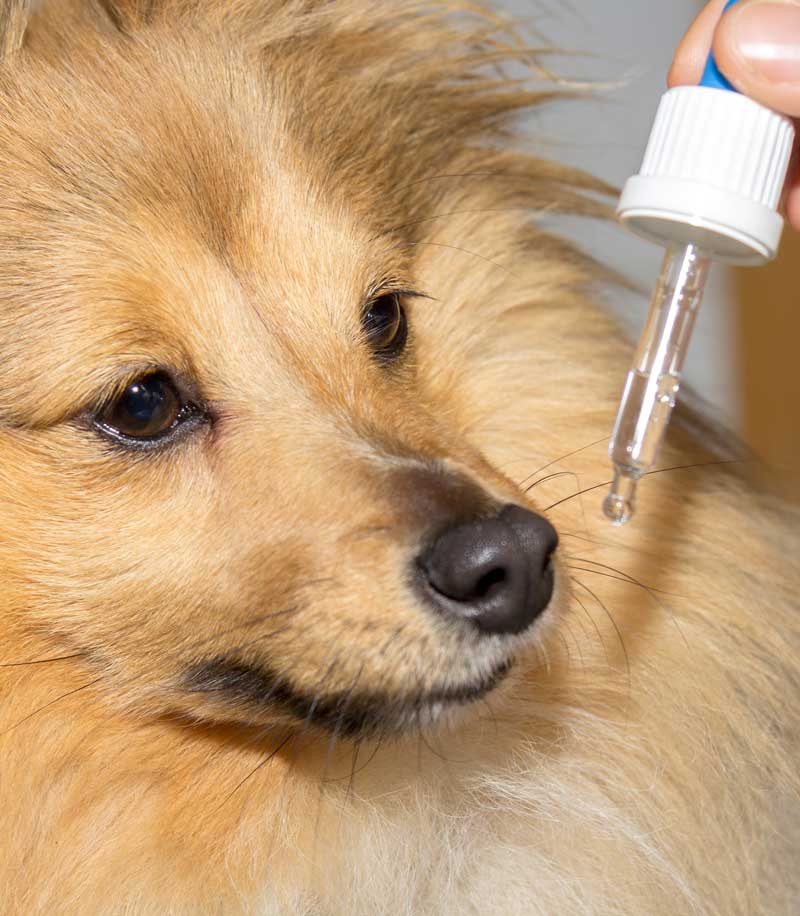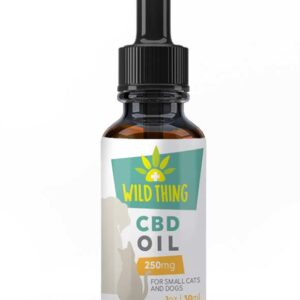Cross-country road trip? Vacation to a beach resort?? Expensive hobby convention in the big city??? No matter where you’re going or why, travelling is almost always exciting… until you look into your dog’s eyes and see the fear, sadness and anxiety. It can be a real “holiday happiness killer”.
The love and loyalty of a dog is one of the best relationships there is in life. Unfortunately, their capacity for affection can also cause them to love and miss you “too much”. Whether you’re going away for some much deserved vacation time, or travelling with your dog in tow, canine travel anxiety can have negative impacts for you and your dog. Most dog owners assume that they’re dog “will get used to it” after a period of time alone or in the car, but the truth of travel anxiety is: it’s effects are not temporary, even if the symptoms might appear to be.
Responsible dog owners often go to great lengths to make their pooches comfortable. A new bone, their favorite bed full of toys and some fancy new wet-food might help your dog cope while you’re away, right? Or maybe you’ve created an entire MacGuyver-esque doggy resort in the backseat while you both travel to some quality camping time? Sometimes it doesn’t matter what you surround your dog with, because internally they are suffering from a serious case of dog anxiety in the car or dog travel anxiety.
Ailment Guides:
Causes of Travel Anxiety in Dogs
Types of Dog Travel Anxiety
There are numerous reasons why your dog never, ever, ever wants to be separated from you, but how do the different types of travel anxiety differ? Do they have similar root causes?
-
“Dog Anxiety in the Car”: this is the classic, most common type of travel anxiety for canines. Some dogs love to go for car rides, others dread it as much as a bath (another concept that has extremes at either end). If your dog suffers from excess panting, slobber, dehydration, nervous twitching, biting or licking when in your vehicle, you might have an anxious motorist in your midst.
-
Separation Anxiety: the measure of any good dog is his/her loyalty. As previously mentioned, “too much” love and need for attention can create an unhealthy balance when a dog’s owner is around or away. Dogs are very impressionable and they operate well within a schedule/routine. Their anxiety can be fueled by long periods of time apart, or by unscheduled or inconsistent lapses in their daily life with family. On top of all this, it is impossible to explain to your dog that “you’re going somewhere for a bit, but you WILL BE BACK!”, so it can be a tall task to calm your dog before, during and after a trip.
-
Sensory Overload: it may seem counter intuitive to your dog’s need to sniff everything, but a dog’s travel anxiety can be heightened by an overload of new experiences. This type of travel anxiety usually manifests when you combine air travel or sailing with an all-new environment that is opposite to your home (i.e. taking your dog from Minnesota to Hawaii). New sights, smells, tastes and sounds are not necessarily a bad thing for your canine; on the other paw, too much of a good thing, too quickly can create a problem.
“Anyone who has attempted to go camping with hyperactive dogs will know this, but my fiance and I found out the hard way about “dog travel anxiety”. Our two Terriers, Jinx and Seamus, are definitely car-ride lovers, but we assumed that taking them on our camping trip to Oregon would be fun for all of us. We couldn’t have been more wrong…
Jinx tore up paper plates, toilet paper and a couple pairs of shoes and Seamus had a spree of “accidents” all over our small camper. We didn’t think of it until after we had returned home, but the trip was an overdose of new sights and smells. We also realized that our dogs really need stable routines – they get their food at 8:00 am and 5:00 pm sharp, they go for a walk around the block 3 times a day, and so on.
We’ve learned about CBD since our “disaster” trip with J&S, so next time around we’ll make sure it’s on our list of essentials when we attempt camping again – that, or we’re going on a dog-cruise!”.
Signs & Symptoms of Dog Travel Anxiety
There are many different signs and symptoms of anxiety in dogs. Each dog’s travel anxiety can show itself in various ways, but the more common symptoms are:
- Sporadic urination, defecation
- Hyperactivity
- Increased saliva, frothing at the mouth
- Nervous itching, licking, biting
- Whimpering
- Inability to stay in one position
- Neediness
- Scratching, pawing or chewing on surroundings
- Aggression
- Dehydration, disinterest in food
Learn More:
Cbd For Senior And Disabled Dogs
Can Cbd Oil Help With A Dogs Sleep And Snoring
5 Pug Health Problems And Grooming Tips
How Can I Calm My Dog’s Anxiety in the Car?
What can you do to ease your dog’s travel anxiety when you absolutely, positively MUST take them with you on a trip/move? Well, for starters, you need to do your best to create a positive & familiar environment for them while travelling.
Learning how to treat a dog’s anxiety is almost more difficult than calming down a child – at least with kids we can talk to them, hear their thoughts and work out a solution. When it comes to administering dog car sickness medicine or calming your canine’s frantic nerves, a pep-talk doesn’t have the same effects because we’re not speaking the same language.
Pets understand body language. Sure, verbal cues can be developed as an effective way of crossing the animal-human communication barrier, but all-in-all it’s how we act, what kind of energy we put forward, and the emotional intelligence between human and animal that lead to the best results.
So, it might seem over simplified at first glance, but the best way to calm your anxious dog down before/during/after travel is to creative a positive and familiar environment for them. This might be as simple as putting their raggy dog bed and favorite toy in the backseat of your car, or it can be as elaborate as white-noise machines, snacks & water, and a car full of friendly (and most importantly DISTRACTING) family & friends.
CBD Oil for Dogs Travelling
Wondering how to treat dog anxiety? CBD can be an effective dog car sickness medicine
What can you do for your dog’s travel anxiety if a trusty blanket/toy or familiar face and soothing comforts aren’t cutting it? Well, there’s always the new age “travel secret” that many pet owners have discovered can work wonders for anxious dogs in planes, trains and automobiles: Cannabidiol.
CBD oil and dog treats are an excellent way to keep your dog happy, healthy and most of all calm during those family trips, camping outings of cross-State moves. CBD has a unique calming effect on frayed nerves, anxiety, stress or irrational fears in both humans and animals. CBD taps directly in your dog’s Encocannabinoid System (ECS) and can help to induce states of calm, relaxation and even assist with sleep consistency/quality.
With CBD oil, a measured dose under your dog’s tongue before a trip can help to cut down on some of those anxious moments on the road. Dog anxiety in the car is the most prominent form of canine travel anxiety, so many pet owners are keeping a bottle of CBD oil in the car with them for whenever those instances of nervousness occur. In the same vein, CBD dog treats are great on-the-go for some much needed calm in the car, on a plane or even before a trip to the vet’s office. Whatever your dog prefers, be it oil or treat, CBD is a great way to take the edge off your pooch’s fears of travel.
You should still try to create a familiar travel atmosphere for your pet, but to provide some extra calm-inducing elements try some CBD oil or dog treats for your dog’s car sickness medicine. Once you’ve tried CBD, we’re confident that you’ll be teaching other pet owners how to treat their dog’s anxiety with just a simple dropper or couple treats of hemp-derived CBD.
Ailment Guides:
Bad Breath In Cats
Kidney Disease In Cats
Anemia In Dogs
FAQ’s
Why does my dog pant and shake when riding in the car?
For many canines, car rides or travelling by any other modes of transportation can be a very stressful experience. The reason why our dogs can become car sick or overly anxious when travelling has to do with how the react to certain stimuli – smells, tastes, sights, sounds and the like. Consider that it is not natural for any animals to travel at high speeds or enter/exit new environments at their convenience, so we need to be cognizant of how the factors of travel can impact their mental & physical wellbeing.
How can I keep my anxious dog calm in the car?
Keeping your dog calm and anxiety/nausea-free can be a difficult task when you’re already trying to focus on the road. To simplify things, always be sure to:
- Monitor your dog’s behavior (be aware of panting, pacing, shedding, licking/biting or whimpering)
- Keep them hydrated
- Bring treats/food
- Take lots of bathroom or walking breaks
- Make sure there’s sufficient airflow in your vehicle
- Create a safe, comfortable space for them (dog beds, favorite toys, etc)
What to give a dog for travel anxiety?
There are some calming formulas of dog treats, capsules, tinctures or topicals you can give to your dog in order to keep them relaxed during travel. CBD derived from hemp is a great option because you can give your canine a dose before, during and after travel.
How long does a dog stay car sick?
Nausea, vomiting, diarrhea and other symptoms of canine travel anxiety can last the entire duration of a road trip – or even extend into the day/night after.








